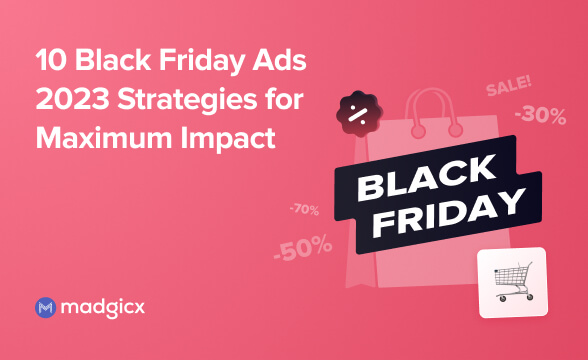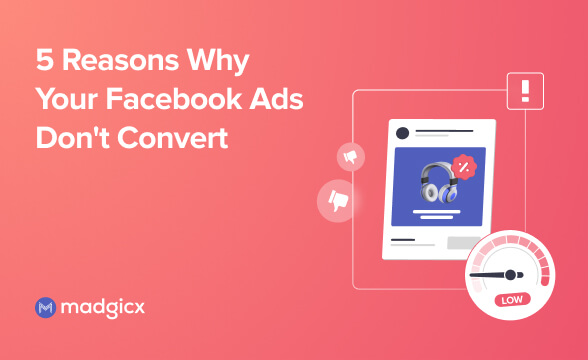Many advertisers focus only on creatives, but without great Facebook ad copy, your ads won't convert. Learn how to write killer copy here.
If you want to create a Facebook ad that draws in a lot of traffic, look at any clickbait ad readily available on your feed. If you want to create a Facebook ad that brings in a lot of traffic AND converts that traffic into paying customers, now you have a killer ad.
It's a common frustration for marketers to create an ad that has high traffic but low conversions. You see your competitors getting results from Facebook ads, but your own ad performance is falling short. You try different creatives but nothing seems to work. Maybe your engagement goes up but not sales.
Before you give up and empty your wallet on another round of AdWords testing, you have to refresh yourself on one critical element of Facebook ads: compelling copy. Using the right strategies and framework for your ad copy, Facebook marketers can start writing newer and improved ads that will consistently produce higher ROI.
By the time you finish reading this article, you should know exactly what to do and what not to do to ensure that you’re putting out killer copy on your Facebook ads.
What is a Facebook ad copy?
A Facebook ad usually consists of a creative (a video or image) along with some text.
.jpg)
Most people get too wrapped up in ensuring that the creative is perfect and completely ignore the text. This text which makes up the Facebook ad copy is crucial to driving conversions.
The ad copy for a Facebook ad can be broken down into three significant components:
The primary text
This refers to the text displayed in the body of the post. The primary text can be a single line or even split up into paragraphs. Depending on your audience, you should experiment and find the optimal length/formatting for your primary text. You can even use emojis for extra flair.
The headline
A Facebook ad headline is the bold text that appears below the creative. Its purpose is to drive conversions by combining effective copy with a compelling CTA. Unlike the primary text, you should keep the headline short, simple and catchy to grab the attention of the audience.
The link description
The link description sits below the headline. It provides you with an opportunity to convince your audience why they should go for the offer on display. It gives your target audience a sneak peek of the value they’ll get from clicking on the CTA button. Depending on the product/service being advertised, you can display information on the pricing or best features.
Does ad copy matter in Facebook ads?
The ad copy essentially functions as the bridge between the creative and the end goal you want to achieve through the ad. When you create an ad, you’re trying to get the viewer to take some sort of action. The first thing the viewer sees is the creative.
A good creative captures attention and sparks curiosity. Once you achieve this, it’s up to the ad copy to carry the viewer to the end goal and successfully convert. Without the copy, it would not be possible to retain the attention generated by the creative. Great Facebook ad copy explains the journey that the viewer will be taking. It paints a picture of how they will be better off after they follow through on the call to action.
Ad copy matters because most viewers see ads as an annoyance and want to skip them even if they are relevant. However, when the ad copy spells out the journey and improvement that the service being advertised can make in the life of the potential customer, then it certainly creates a huge impact on most viewers.
Without the text that grabs their attention and compels them to take action and follow through on their impulses, most ads would not convert. So ignoring this is one of the biggest mistakes you could possibly make and will definitely hurt your conversion rate.
A well-crafted Facebook ad copy can catch the excitement that the image creates and build on it. A great ad copy drives the ad home, and a poorly written copy can have a huge negative impact on the impact your ads make.
Facebook ad copy limits
There are a number of places ads can be displayed to Facebook users, and the details for each kind vary. Ads can be either image, video, carousel, or collection. Let’s take a look at some types of Facebook ad formats and how their placement affects the character limits and the ad copy.
1. Image ads
Facebook Image ads are some of the most popular ads out there. When placed in the feed, which is basically prime real estate on Facebook, they can deliver great results. The primary text should be around 125 characters as anything longer will be truncated. Any primary text above 125 characters can be seen by clicking the “see more” option. The headline allows for 27 characters, and the description is 27 characters too.
When placed in the right column of Facebook, it only allows for a 40 character headline. When placed in the Story or Facebook Messenger inbox, it allows only primary text and a headline with the above character limits.
2. Video ads
When it comes to video ads, the limits on the ad copy are similar. Video ads are a great way to capture your audience’s attention and if done correctly can really drive home a resounding message. When placed in the Feed or Facebook Marketplace, the primary text should be around 125 characters as anything longer will be truncated, and the headline and description allow for 27 characters each.
When broadcasted as an Instant Article, or within a Story, there is no place for a description. The primary text and headline character limits remain the same.
3. Carousel ads
The Carousel feature allows you to showcase up to 10 images and videos in a single ad, each with its own link. It gives you more creative space within an ad to highlight specific features about a product, showcase different products, or promote a service. You can even use it to tell a story about your brand.
When placed in the News Feed, a Carousel ad's primary text should follow the same length as both image and video ads, headlines with 32 characters, and descriptions with 18 characters. You must include a landing page URL as well. When placed in the right column, they can only contain a headline of 40 characters and must have a landing page URL. When placed in Facebook Stories, just the primary text and landing page URL are allowed.
4. Collection ads
The Collection ad format is the choice of ads if you’re targeting mobile devices. It’s a visual and immersive way for people to discover, browse and purchase items while on their phones. When someone taps on a Collection ad, they get taken to an immersive landing page that drives engagement and captures interest.
Again, anything above 125 characters will be truncated, however, a 40 character headline is allowed. There is no description however a landing page URL is required. These limits remain the same when placed in a Facebook in-stream video.
It’s worth taking the time to properly plan out your Facebook ad size and specifications because everything from where you place your ad to what the limits are on it will affect your campaign.
Keep in mind that these limitations will also change as time goes by and Facebook continuously updates its guidelines. Earlier, Facebook used to limit the text in ad creatives to 20% of the image, but it removed this limitation in September 2020 so now you no longer have to follow these restrictions.
6 best practices and winning Facebook copywriting strategies
When it comes to Facebook copywriting, there are a few tried and tested best practices that you should keep in mind and be sure to include for the best results. Let’s take a look at some of these:
1. Start with audience targeting
Before you begin to write copy for your audience, make sure you know exactly who your audience is composed of. Understand what your normal demographic looks like and how they interact with the Facebook platform. Ask yourself questions like:
- What do they like and what are their interests?
- Where are they based geographically?
- What is their age group?
- What does their online behavior look like?
Once you know your target audience intimately, it’s easier to write specific copy that will be more likely to catch their interest.
2. The hook
The hook is one of the most important parts of the ad copy. A good hook should do exactly what it says and hook your audience. It captures interest early and keeps them reading. Some great ways to hook your audience are:
- Using numbers: When you use a number in the hook, like a percentage, figure, or statistic, it immediately lends credibility and makes what you’re about to say sound more factual and scientific.
- Arouse curiosity: A hook needs to pique interest early on, and you can do this by using phrases such as “What if I told you?” or other similar questions that readers are naturally drawn to.
- Incite fear: Fear can be a powerful motivator when trying to convince your audience to do something. The fear of missing out (AKA FOMO) or the fear of falling behind the competition can be powerful tools to use in a hook.
Now let’s take a look at some types of hooks:
First, the pain/benefit hook is a great one to use. It’s simple and effective and directly addresses the primary pain point a customer may have. Then, it points to the solution your product can provide, which is exactly what the audience is looking for. This format is simple yet effective.
Next, there’s the empathy hook. This hook shows that you understand what your audience is currently going through and makes them feel like they aren’t alone. It relates to a situation people who need your product or service usually find themselves in. It demonstrates that as a brand you’ve been there and that you care.
Lastly, the Logic hook appeals to rational people who feel compelled to side with something that makes sense to them. In a logic hook, very early in the ad copy, one finds a statement that’s true and factual. This builds trust and makes you agree with what you’re reading, which is likely to keep you interested until the end.
3. Use a clear call to action
People are more likely to follow through on what they read and take action if they are told exactly what to do. A call to action (CTA) is clear and easy to understand. It should make the reader feel excited about the prospect of taking action. It also needs to be simple and concise and shouldn’t be lengthy, winding, and wordy. As far as possible, keep CTAs to a maximum of three words.
4. Test multiple ad copy variations
There’s absolutely no reason to stick to a single version of the ad copy. You should actively be tweaking, experimenting, and changing part of the ad copy and monitoring how each version performs and what you can do to improve upon it. Every individual reacts differently to the information they see and what converts one person may not convert the next. The more versions you test out, the better your chances of finding out what works and what doesn’t.
5. Avoid words and phrases that might cause Facebook to reject your ad
There are several reasons Facebook could reject your ads. Meta does not allow to advertise weapons, ammunition, explosives, unsafe supplements, cryptocurrencies, and anything illegal on Facebook. However, there are also other reasons Facebook might reject your ad even if your product is perfectly legal.
Your ads need to follow Facebook’s community standards and ad guidelines at all times. This means no promoting violence, showing objectionable content, and stealing intellectual property. Facebook might also reject your ad for making a mistake in your creative and violating one of the guidelines.
You also are not allowed to imply that you know anything about the users you’re targeting. Here are a few examples:

6. Use proven copywriting formulae and techniques
Copywriting formulae and techniques exist for a reason. It’s because they work and have great success rates. So, it’s not a bad idea to incorporate them into your Facebook ad copy. Here are a few you can use today.
FOMO basically stands for Fear Of Missing Out, which is when a person is afraid they will miss out on something if they don’t take immediate action. FOMO copywriting creates the feeling of exclusivity and time-sensitive urgency. It builds the feeling within the reader that they’re about to miss out on an opportunity that’s slowly slipping away already unless they follow your CTA.
Social Proof is basically real-life feedback with approval from your customers. Most readers want to know what other people think. So, leveraging testimonials in your copywriting to showcase people’s positive opinions on your product can be a great idea when executed well. With social proof, testimonials could even be stronger if they come from experts or celebrities. Basically, anyone with social status or authority in the relevant niche will be helpful. If you’re trying to retarget ads for people who already know your product, then instead of wasting time reintroducing your brand, you can focus on using social proof to boost your credibility.
AIDA stands for Attention, Interest, Desire, and Action. This is one of the oldest copywriting formulae out there. It functions by first calling the reader's attention to something, followed by persuasive writing that generates interest. Then you focus on building desire within the reader. Finally, in the end, you call them to take action and purchase a product. AIDA has proven to work well consistently for many marketers and is a time-tested technique that remains evergreen.
Before-After Bridge is used to make an emotional connection with your audience. When using a Before-After Bridge, you first bring attention to the current situation where a problem exists. Then you help them imagine a world where this problem no longer exists. Once you have shown the problem and the world without it, you then market the bridge which is technically the solution to the problem. The bridge carries the reader from the world with a problem, to some imaginary perfect world without that pain. Once you’ve done this, the viewer feels compelled to follow through so they can live without the problem and eliminate the pain.
Open Loop refers to a practice where you tell a story through your copywriting but never conclude it. Leaving the story unfinished makes your audience desperate to seek out more information so they can satisfactorily conclude the story and reduce the feeling of anxiety that accompanies not knowing the conclusion.
The best Facebook ad copy examples in 2022
Let’s take a look at some very well-written Facebook ads and analyze what they’re doing right.
Ad World Conference
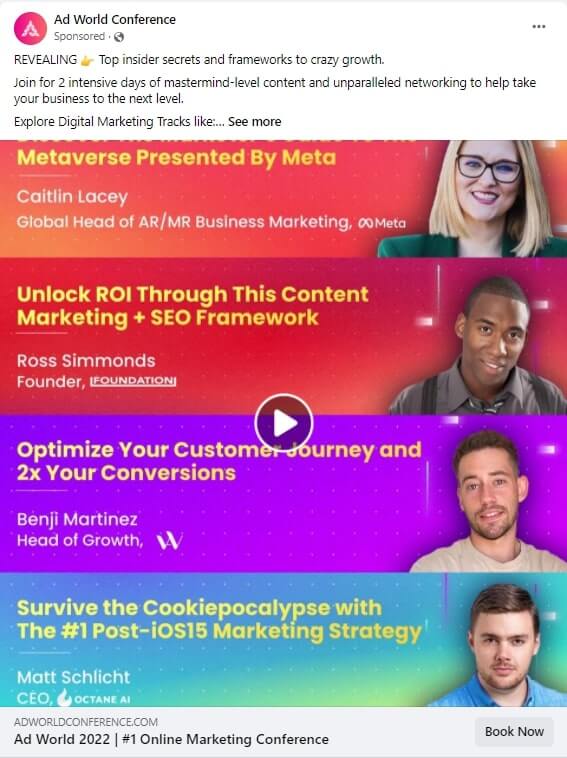
First, let’s analyze this Facebook Feed ad for the Ad World online marketing conference. The copy begins by grabbing your attention with the word ‘REVEALING” almost as if something exciting is about to be uncovered. It then quickly moves to promise to reveal the top insider secrets and frameworks for growth.
This creates a feeling of exclusivity. The reader feels as if they're going to be an insider if they can learn these secrets. At the same time, the promise of growth, opportunity to network, and vibrant creative showcasing some experts from their respective fields all create a sense of urgency and excitement and make you want to attend Ad World.
Jim Kwik

This ad is a little different from the previous one but it’s also very well done. The creative looks engaging and asks the question “Are you ready to read 3x faster in 21 days?” using a large font size right in the middle. There’s also a big CTA button asking you to sign up below.
But what makes this a great ad is the copy. The first line promises that not only will you be able to read faster but also smarter after purchasing this reading program. This addresses the pain of not being able to read fast and also throws in the fact that you’ll be able to read smarter if you follow through and sign up.
The next line talks about how the program is divided into 21 online daily sessions but that each session is just 15-20 minutes. That's a small amount of time to spend each day trying to improve your reading speed.
Liferay
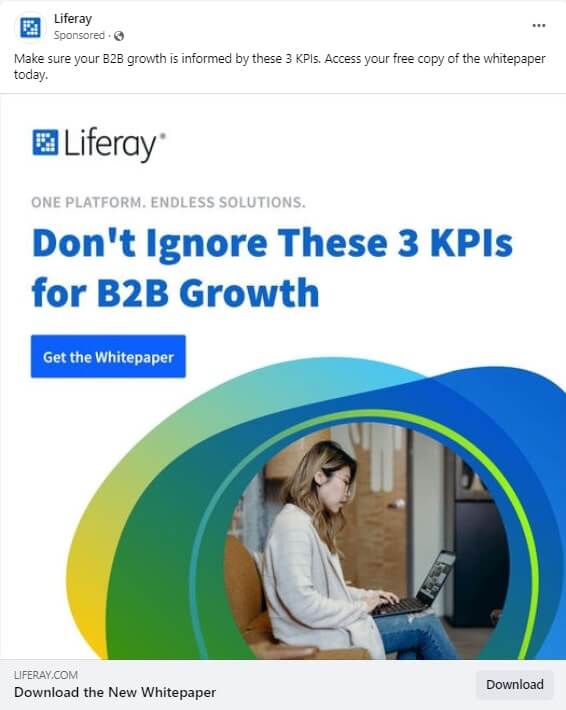
Finally, let’s take a look at this ad by Liferay. Although this is fairly simple, it’s a great example of an Open Loop in advertising copy.
The copy mentions that your B2B growth needs to be informed by “these 3 KPIs." This starts a story about 3 KPIs that are crucial to B2B growth, but it does not complete the story.
Due to human nature, your curiosity to know the truth is amplified, and you feel compelled to click on the ad to find out what the 3 KPIs are. The creative is also quite nice and has a big CTA button right in the middle. For all these reasons, we consider this an effective Facebook ad copy.
Write better ad copy faster with the AI Copywriter
Writing copy usually requires lots of time-consuming iterations. Especially, while brainstorming and doing content revisions. Fortunately, there are now more intelligent ways of getting ad copy written quickly.
By using Madgicx’s AI Copywriter, you can now generate great content without all the dreadful parts involved in writing copy. It’s also based on your ad performance, so you receive AI-powered personalization to help drive the best results and find what works best for your business.
The AI Copywriter allows you to test as many versions of an ad as you want in one go. What’s more is that it also lets you generate multiple ads using proven copywriting techniques such as FOMO, AIDA, before-after, and more.
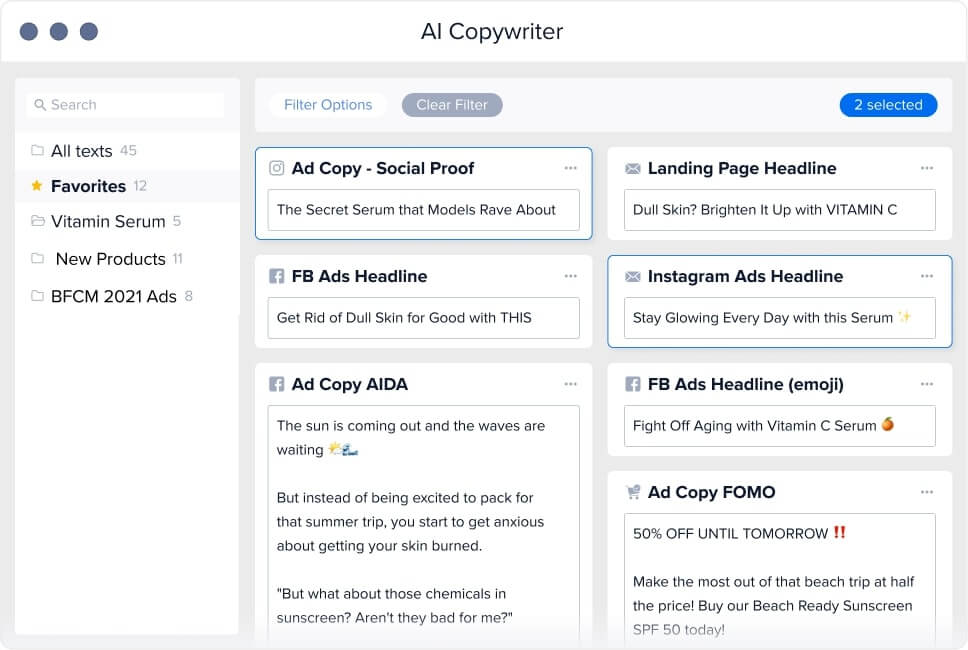
You can save and organize everything effectively in one collaborative library and even get content for every single stage of your sales funnel, from Facebook ads for acquisition and retargeting to product descriptions and landing page headlines for your website.
Now if you’re also on the lookout for an analytics tool then Ad Copy Insights just might be the perfect fit for you. Using AI, it allows you to fine-tune your Facebook ad copy and helps you decide what to drop and what to scale. This tool also identifies and tags language elements that drive performance across different audiences in order to determine which words sell best and help refine your copy.
By letting you find scalable pieces of copy, identifying the core performers that are absolutely essential, and letting you test new copy you begin to obtain a more holistic view of your ad copy. What’s more, by analyzing your data, Ad Copy Insights also helps you find solutions to nuanced questions such as how many words to use to convert best and whether or not you should be elaborating more in your ad copy.

For the highest odds of success, it’s probably smart to use these two tools together. You can obtain valuable and practical insights using Ad Copy Insights to better understand what resonates with your audience. Then, you can use the AI Copywriter to produce more polished ad copy based on these insights.
Armed with both these tools and the knowledge in this article, your ad copy is certain to be nothing short of exceptional. Now that you have the secret to writing killer Facebook ad copy that converts like crazy, there should be nothing stopping you from creating great Facebook ads with insanely high conversion rates.
Get all the tools you need to analyze your ad copy performance, test all the angles you should test, and drive conversions like never before.
Michael Rarick is the CEO of Mediaberry. His mission is to help SaaS companies grow their market share through white-hat, relationship-based SEO.







